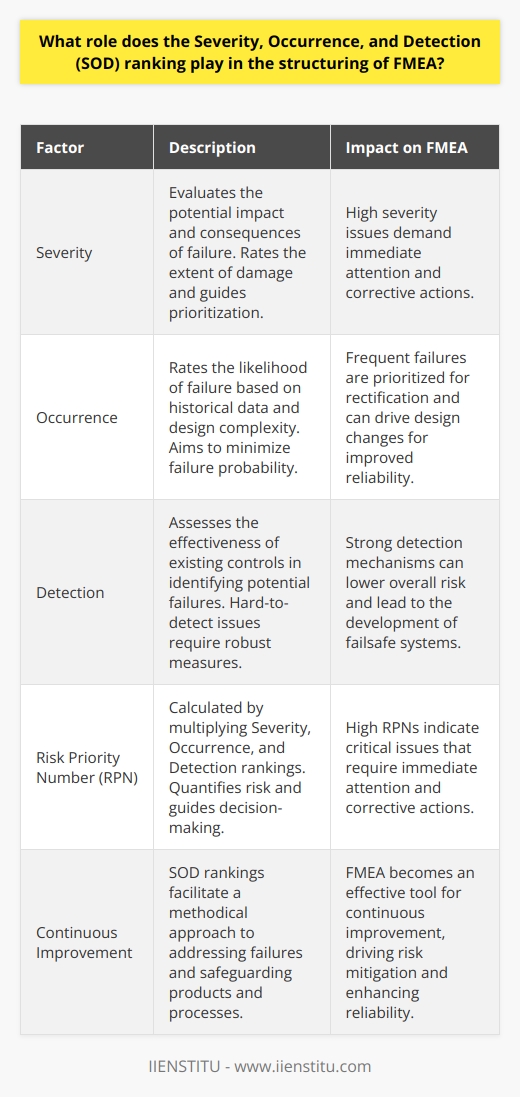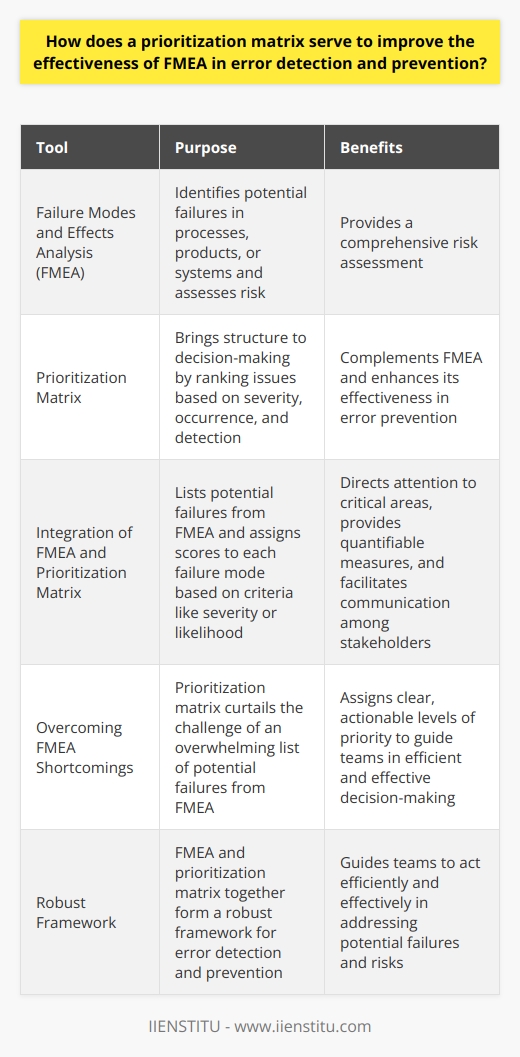Failure Modes and Effects Analysis (FMEA) is a systematic, proactive method for evaluating a process to identify where and how it might fail and to assess the relative impact of different failures, in order to identify the parts of the process that are most in need of change. FMEA analyzes potential failures using three criteria: occurrence, severity, and detectability.
The practice originated in the 1940s, developed by the U.S. military, and has since evolved into a crucial tool in various industries, including automotive, aerospace, and healthcare, promoting safety and reliability in products and processes. This comprehensive study delves into the nuances and applications of FMEA, shedding light on its significance and providing the reader with a sound understanding of its multifaceted nature.
The importance of FMEA cannot be overstated—it offers organizations a detailed and systematic approach to identify and mitigate risks before they lead to incidents. This preemptive problem-solving tool not only saves costs related to fixing issues post-production but also enhances the safety and quality of the output, which, in turn, builds customer trust and loyalty. Furthermore, the insights gleaned from FMEA can be pivotal in refining production processes and product designs, ensuring improved performance and competitiveness in the market.
Understanding Failure Modes and Effects Analysis (FMEA)
Definition of FMEA
Failure Modes and Effects Analysis (FMEA) is an analytical methodology used to ensure the identification of potential failure modes for a product or process, to assess the risk associated with those failure modes, to rank the issues in terms of importance, and to identify and carry out corrective actions to address the most serious concerns. FMEA serves as a blueprint for risk reduction and is fundamental in the field of quality engineering and risk management.
Purpose of FMEA in various fields
In different sectors, from manufacturing to services, FMEA serves a pivotal role in risk management and quality improvement. For manufacturing, it helps in scrutinizing product design or production processes for potential weaknesses. In the healthcare field, it's used to improve patient safety by identifying possible points of failure in healthcare delivery. The aerospace and automotive industries use FMEA to meet rigorous safety standards and regulations, preventing failures that could be catastrophic due to the high risk associated with their products and services.
Historical development of FMEA
The genesis of FMEA traces back to the 1940s when the U.S. military introduced the procedure to mitigate risks in the defense systems. The methodology was further refined and adopted by the aerospace industry in the 1960s, especially during the Apollo missions to ensure the reliability of spacecraft. Over time, the automotive industry, particularly Ford Motor Company in the 1970s, followed suit, integrating FMEA into their quality assurance practices. Today, FMEA is a cornerstone of industry-wide risk management strategies, continually evolving with the complexity of modern engineering and business practices.
The Process of FMEA
Identification of potential failures (failure modes)
The first step in FMEA involves the identification of potential failures, also known as failure modes. Failure modes are the ways in which a process, design, or product can fail to meet the desired performance criteria. These could range from minor inconveniences to catastrophic failures that cause harm or even loss of life. Identifying failure modes requires a deep understanding of the system or product being analyzed and often involves brainstorming sessions with a multidisciplinary team.
Analysis of effects and consequences
Once the potential failure modes are established, the next phase of FMEA is to examine the effects and consequences of these failures. This analysis is crucial to understand the impact of the failures on the system, user safety, and overall product or process performance. This step determines the severity of each failure mode and can often lead to insights into the interconnectedness of system components and how they may contribute to unintended outcomes.
Risk assessment
The culmination of identifying and analyzing failure modes leads to risk assessment. This is usually quantified by the Risk Priority Number (RPN), which is a product of three factors: severity, occurrence, and detectability. The RPN helps in prioritizing which failure modes require immediate attention and resources to mitigate risks. A robust understanding and application of risk assessment within FMEA allow organizations to allocate their efforts effectively and prevent failures efficiently.
Types of FMEA
Design FMEA
Design FMEA (DFMEA) focuses on potential failures related to product design before they are put into production. It helps designers forecast and eliminate flaws during the earliest stages of product development. Design FMEA ensures product reliability and safety, preventing costly recalls and brand damage. Examples of design FMEA can be found in the automotive industry where DFMEA is fundamental in vehicle systems, from brakes to electronic components, to ensure that the design is robust against possible failure modes.
Process FMEA
Process FMEA (PFMEA), on the other hand, is used to analyze manufacturing and assembly processes. It aims to eliminate risks associated with the production of goods by identifying potential failures that could arise from the malfunction of machinery, human error, material issues, or ineffective control measures. By examining these potential sources of failure, organizations can modify their processes to increase efficiency and reduce the likelihood of product defects. For instance, in semiconductor manufacturing, PFMEA could be applied to reduce the risk of defects in the wafer production process.
Steps in Conducting FMEA
Assembling the team, reviewing the process or design, identifying potential failure modes, evaluating the effects and risks, developing action plans, and implementing and reviewing the effectiveness of the plans constitute the systematic steps to conduct an effective FMEA. Each of these steps requires meticulous attention and coordination among the team members, often calling upon the expertise of engineers, technicians, and managers.
The team's composition is as important as the subsequent steps since the collective experience and knowledge influence the outcome of the FMEA. Reviewing the process or design in question is performed with the intent to understand every single element and interaction within the system. This stage sets the groundwork for the subsequent identification of potential failure modes.
Evaluating the effects and risks allows the team to prioritize issues based on severity and likelihood. It is a stage that demands critical thinking and objective assessment. Developing action plans involves strategizing how to address, mitigate, or eliminate the identified risks, while implementation and review ensure that the strategies are put into practice and are effective in enhancing the reliability and safety of the product or process.
Benefits and Limitations of FMEA
Advantages of using FMEA
Among the advantages, FMEA provides a structured approach for organizations to preemptively prevent malfunctions. It has the potential to significantly reduce the incidence of product recalls and defects, which protects the consumer and fortifies the company's reputation. This preventive action saves costs associated with post-market fixes and contributes to customer satisfaction and loyalty. Moreover, FMEA facilitates regulatory compliance in industries where safety is critically regulated, providing documented evidence of due diligence in risk management.
Limitations of FMEA
However, FMEA comes with its limitations. The process can be complex, requiring significant time and resource investments. The effectiveness of an FMEA is highly dependent on the experience and the analytical capability of the team conducting it. If the team lacks the necessary expertise or if they do not have a comprehensive understanding of the product or process, there is a risk of overlooking significant failure modes or misjudging their impact.
Case Studies and Examples of FMEA Application
FMEA in the automotive sector
In the automotive sector, FMEA has become an integral part of the design and manufacturing process. For instance, when a new vehicle model is being developed, design FMEA is implemented to address any possible issue that can lead to safety hazards or malfunctions before the model is mass-produced. This proactive measure can prevent massive recall campaigns that incur significant costs and affect the brand's reputation.
FMEA in the healthcare industry
In healthcare, FMEA has been used to improve patient safety. A well-documented case is the use of FMEA in reducing medication errors in hospitals. By analyzing the medication administration process, potential errors were identified and changes were implemented, such as standardizing the medication labeling and enhancing the electronic medical record system, which led to a substantial decrease in prescription and administration errors.
FMEA in manufacturing
Similarly, FMEA exercises in the manufacturing sector have led to significant improvements in product quality and process efficiency. An electronics manufacturer, for instance, applied process FMEA to their circuit board assembly line and identified a high risk of component failure due to electrostatic discharge. The subsequent action reduced component failure rates, enhanced product reliability, and resulted in cost savings by minimizing waste and rework.
Conclusion
Throughout this comprehensive study, the multifaceted approach of Failure Modes and Effects Analysis (FMEA) has been discussed, highlighting its critical role in predicting and preventing potential failures across various industries. The future trends and developments of FMEA are leaning towards integration with other risk assessment tools and the utilization of advanced data analytics for even finer precision in identifying and mitigating risks.
Our reflections on the effectiveness and importance of FMEA stand firm—it remains an invaluable tool in promoting the reliability and safety of products and processes while serving as an essential part of risk management and regulatory compliance. As we continue to confront complex technical challenges in product design and process development, FMEA provides a structured and robust methodology to guide us toward innovative solutions and continual improvement.








